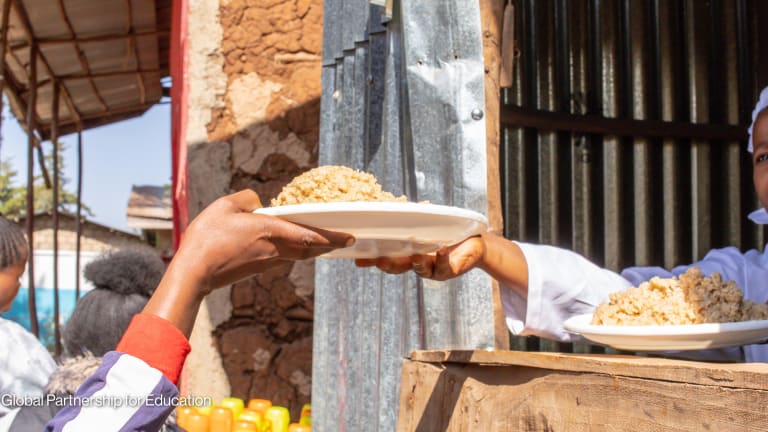World Bank: 'We're nowhere near out of the woods' on food price crisis
Two World Bank experts lay out the short-term invention to help the most vulnerable deal with the food price shocks, but stress climate change, supply chain concentrations, and debt need to be addressed to build resilient and sustainable food systems.
Food prices and fertilizer costs remain at historical levels, despite some reductions in recent months. At the same time, countries’ economies are slowing and inflation is rising, making it harder for people to purchase food. Two experts at the World Bank warn that this paints a grim outlook for food security. In a joint interview with Devex, Madhur Gautam, lead agriculture economist at the bank, and his colleague Julian Lampietti, a practice manager for agriculture and food, say that food systems are unstable and vulnerable, meaning that even small shocks can cause immense harm. But recent changes have not been small shocks. The combination of already high debt and more recent currency devaluations because of a strong dollar, along with climate change and supply chain disruptions from the war against Ukraine, are battering fragile countries. Gautam and Lampietti are warning of a “perfect storm.” This interview was edited for clarity and length. “A weakening economy means falling income. And access to food requires incomes to be robust. And a lot of countries are facing fiscal stress and debt levels are also constraining. … There is a combination of factors at play creating the perfect storm.” --— Madhur Gautam, lead agriculture economist, World Bank Heading into the winter in the Northern Hemisphere, what’s your view on the food situation? Gautam: Food prices are still historically high despite some recent easing. And energy prices are still very high and that has a significant impact on food prices. So, we're nowhere near out of the woods yet. Prices have, in some cases, come down from where they were after the jump in February. What are the drivers of that? Well, the resumption of grain trade in the Black Sea, but also the weakening of economies is starting to factor in. And, if that is the case, then the outlook does not look particularly bright at this point from a food security point of view. We expect food insecurity to increase further. Which areas of the world are being most impacted by these high wheat and maize prices? Gautam: The countries that are importing food are impacted more than other countries. Other countries are also impacted by high domestic inflation. High energy prices are putting on more pressure. And this is combined with high fiscal stress after two years of COVID response. Stress points are in the Middle East and North Africa, along with sub-Saharan Africa, where there are also other stresses such as the drought in East Africa. In Asia, there is Afghanistan, and Pakistan is now coming on, along with Sri Lanka, which also has other issues. And in Central America too. As economies weaken, even if food prices come down, it sounds like food security will remain an issue. Gautam: A weakening economy means falling income. And access to food requires incomes to be robust. And a lot of countries are facing fiscal stress and debt levels are also constraining, while high foreign exchange rates are raising domestic prices. There is a combination of factors at play creating the perfect storm. How is the World Bank able to respond when it’s not a single issue causing the problems? Lampietti: We have a very ambitious program that we launched in April of this year, and that will run until June 2023. It's a $30 billion program. That includes about $18 billion of money that's already in the system and $12 billion of new lending. We do everything from strengthening safety nets, so that they can better target the people most in need, all the way to figuring out ways to help farmers become more efficient in their application of fertilizer. We have the full gamut of options available to our client countries. And they come to us and work with our task teams to really determine what is the best fit for them. You have short-term social assistance and medium-term interventions on fertilizers, but what are your long-term plans, so that there is more resilience built in? Lampietti: There’s huge momentum at a global level that we’ve got to deal with the immediate crisis. But unless we build a better food system, we're never going to stop these crises from happening. This is the second food crisis in about 10 years. We are working with the countries, where they have the space, to look at longer-term investments. One really promising area is subsidies, and how we can help governments rethink how they spend money supporting their agriculture and food sectors. For example, how do I sort of look at soil health or other indicators that will really mean a difference for the farmer over a long term. If we can finance better soil health, then farmers will make better choices. This is to focus on the quality of the soil for the production of the crops, rather than on the inputs, like fertilizer. Could we be entering an era where food crises are more frequent? What’s driving that? Gautam: I think climate change is a big driver. If you look at where the acute food insecurity hotspots are, these are the areas that are, by some assessments, the most affected by climate change. It’s not a surprise. And it looks like it’s probably going to continue, in terms of shortening the frequency of how often this happens. We hope it doesn’t, but the signs right now don’t look particularly good. The other issue is getting countries back on their feet, both fiscally and productively. And that’s where our food system 2030 agenda comes in. This is really our bread and butter at the bank, the long-term structural issues. Technology, innovation, digital agriculture, agribusiness, healthy diets, climate, smart agriculture, resilience. We have to get these policies right. Lampietti: This is a very complex problem. It’s an inherently unstable system that's becoming more unstable, and you get one shock and it causes the whole thing to suddenly get all tippy. Climate change is a huge part of the instability, but it’s not the only thing. We are seeing smaller and smaller shocks have bigger and bigger impacts. And adding to that is market concentration and the instability that creates. Can you give some examples? Lampietti: During COVID, grocery store shelves were empty, but farms were full of food. You had key points in the supply chain that were hyper-concentrated, like the four slaughterhouses through which 80% of the meat is processed, they were just knocked out. Similarly, the Black Sea is a major shipping route. The countries that depend on the grain that comes out of Ukraine and Russia and Kazakhstan, many years ago, were sourcing from multiple countries in a much more diversified way. Now, you’ve got this hyper-efficient, extremely concentrated supply chain, and boom, it gets hit, it goes out, and it's very hard for people to adjust. So how do we think about building more resilient systems that are networks rather than single lines. What can governments do right now? Are you looking for specific intervention through the bank? Lampietti: Countries need to not do silly things, like raise tariff barriers on food. As long as we are all working together, that will help the situation. One product that we've been working on as part of the Global Alliance for Food Security, which is this initiative launched at the G-7, is a way to put all of the data and information around food security in one place. To come up with better, faster, more informed decisions. Gautam: One issue is what can we do to ease the fiscal burden and debt. The other issue is what I call the $640-billion question. That’s what governments around the world support in agricultural subsidies and policies. So can we use that better? Can we start to use some of that to do more good than harm? Plenty of evidence shows it can be used to deliver multiple wins — better food security, better nutrition, better environmental outcomes, and farmers will be better off, everybody's going to be better off.
Food prices and fertilizer costs remain at historical levels, despite some reductions in recent months. At the same time, countries’ economies are slowing and inflation is rising, making it harder for people to purchase food. Two experts at the World Bank warn that this paints a grim outlook for food security.
In a joint interview with Devex, Madhur Gautam, lead agriculture economist at the bank, and his colleague Julian Lampietti, a practice manager for agriculture and food, say that food systems are unstable and vulnerable, meaning that even small shocks can cause immense harm.
But recent changes have not been small shocks. The combination of already high debt and more recent currency devaluations because of a strong dollar, along with climate change and supply chain disruptions from the war against Ukraine, are battering fragile countries. Gautam and Lampietti are warning of a “perfect storm.”
This story is forDevex Promembers
Unlock this story now with a 15-day free trial of Devex Pro.
With a Devex Pro subscription you'll get access to deeper analysis and exclusive insights from our reporters and analysts.
Start my free trialRequest a group subscription Printing articles to share with others is a breach of our terms and conditions and copyright policy. Please use the sharing options on the left side of the article. Devex Pro members may share up to 10 articles per month using the Pro share tool ( ).
Shabtai Gold is a Senior Reporter based in Washington. He covers multilateral development banks, with a focus on the World Bank, along with trends in development finance. Prior to Devex, he worked for the German Press Agency, dpa, for more than a decade, with stints in Africa, Europe, and the Middle East, before relocating to Washington to cover politics and business.








